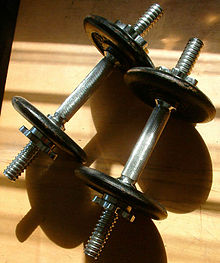The dumbbell, a type of free weight, is a piece of equipment used in weight training. It is usually used individually and/or in pairs, with one in each hand.

History
editThe forerunner of the dumbbell, halteres, were used in ancient Greece as lifting weights[1][2] and also as weights for the ancient Greek version of the long jump.[3] A kind of dumbbell was also used in India for more than a millennium, shaped like a club – so it was named Indian club.[4][5] The design of the "Meel", as the club was referred to, can be seen as a halfway point between a barbell and a dumbbell. It was generally used in pairs, in workouts by wrestlers, bodybuilders, sports players, and others wishing to increase strength and muscle size.
Etymology
editThe term "dumbbell" or "dumb bell" or "dumb-bell" originated in late Stuart England. In 1711 the poet Joseph Addison mentioned exercising with a "dumb bell" in an essay published in The Spectator.[6]
Although Addison elsewhere in the same publication describes having used equipment similar to the modern understanding of dumbbells, according to sport historian Jan Todd, the form of the first dumbbells remains unclear.[6] The Oxford English Dictionary describes "apparatus similar to that used to ring a church bell, but without the bell, so noiseless or ‘dumb’", implying the action of pulling a bell rope to practice English bellringing.[7]
Types
editBy the early 17th century, the familiar shape of the dumbbell, with two equal weights attached to a handle, had appeared.[8] There are currently three main types of dumbbell:
- Fixed-weight dumbbells are weights created in a dumbbell shape. Inexpensive varieties consist of cast iron, sometimes coated with rubber or neoprene for comfort, and even cheaper versions consist of a rigid plastic shell that is filled with concrete.
- Adjustable dumbbells consist of a metal bar whose centre portion is often engraved with a crosshatch pattern (knurling) to improve grip. Weight plates are slid onto the outer portions of the dumbbell and secured with clips or collars. Shown to the right is a "spinlock" dumbbell, whose ends are threaded to accept large nuts as collars. Alternatively, a dumbbell may have smooth ends with plates being secured by a sprung collar.
- Plate-loaded (adjustable) dumbbells (a.k.a. loadable dumbbells)
- Spin-lock
- Spring collar clips
- Compression ring collar
- Ironmaster quick-lock
- Selectorized (adjustable) dumbbells are adjustable dumbbells that allow you to easily alter the weight or number of plates while the dumbbells are resting in the stand. This is accomplished through controlling the amount of plates that follow the handle when lifted, for as by turning a dial or sliding a selector pin, rather than physically adding or removing plates. This makes it simple to adjust the weight of the dumbbell between exercises, and the stand is typically used to hold extra weights that aren't required for a certain exercise. There are different types of mechanism:
- Block type
- Dial type
- Glide type
- Twist type
- 2-in-1 dumbbell/barbell
- Plate-loaded (adjustable) dumbbells (a.k.a. loadable dumbbells)
Variations
edit- Thomas Inch dumbbell, also known as "172" (2.38 inches (60 mm) handle, weighs 172 pounds (78 kg))[9]
- Millennium dumbbell (2.38 inches (60 mm) handle, weighs 228 pounds (103 kg))
- Circus dumbbells: historically used in traveling circus acts, these dumbbells have exaggerated ends and wider handles, and just like normal dumbbells, come in various weights and sizes.
See also
editReferences
edit- ^ Gardiner, E. Norman (2002). Athletics in the Ancient World. Courier Corporation. p. 153. ISBN 978-0-486-42486-6.
- ^ Pearl, Bill (2005). Getting Stronger: Weight Training for Sports. Shelter Publications, Inc. p. 388. ISBN 978-0-936070-38-4.
- ^ Miller, Stephen Gaylord (2004). Ancient Greek Athletics. Yale University Press. p. 64. ISBN 978-0-300-11529-1.
halteres halter.
- ^ Heffernan, Conor. "INDIAN CLUB SWINGING IN NINETEENTH AND TWENTIETH-CENTURY INDIA AND ENGLAND" (PDF).
- ^ Heffernan, Conor (2016-07-05). Indian club swinging in nineteenth and twentieth-century India and England (Thesis thesis). Faculty of History, University of Cambridge.
- ^ a b Todd, Ph.D., Jan (1 April 1995). "From Milo to Milo: A History of Barbells, Dumbells, and Indian Clubs" (PDF). LA84 Foundation. Iron Game History: The Journal of Physical Culture. p. 6. Archived from the original (PDF) on 18 November 2017. Retrieved 25 January 2016.
- ^ Oxford dictionary definition and etymology
- ^ Hedrick, Allen (18 Jan 2014). Dumbbell training. Human Kinetics. p. xii.
- ^ "INCH 101: Mark Henry's Successful Lift With Inch Dumbbell!". bodybuilding.com. 2008-03-30. Retrieved 2020-04-14.
External links
edit- Media related to Dumbbells at Wikimedia Commons